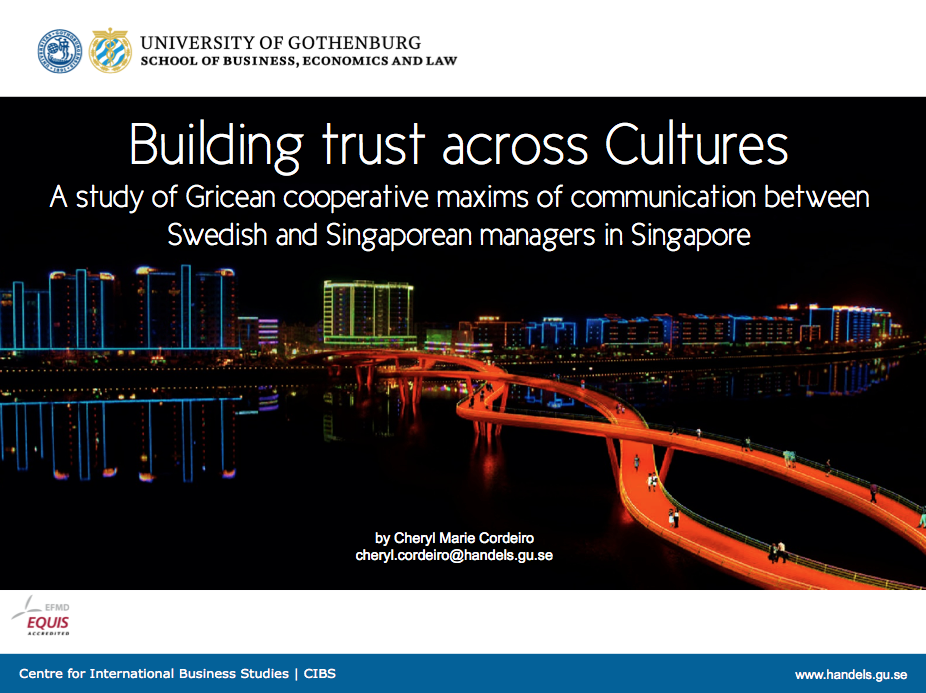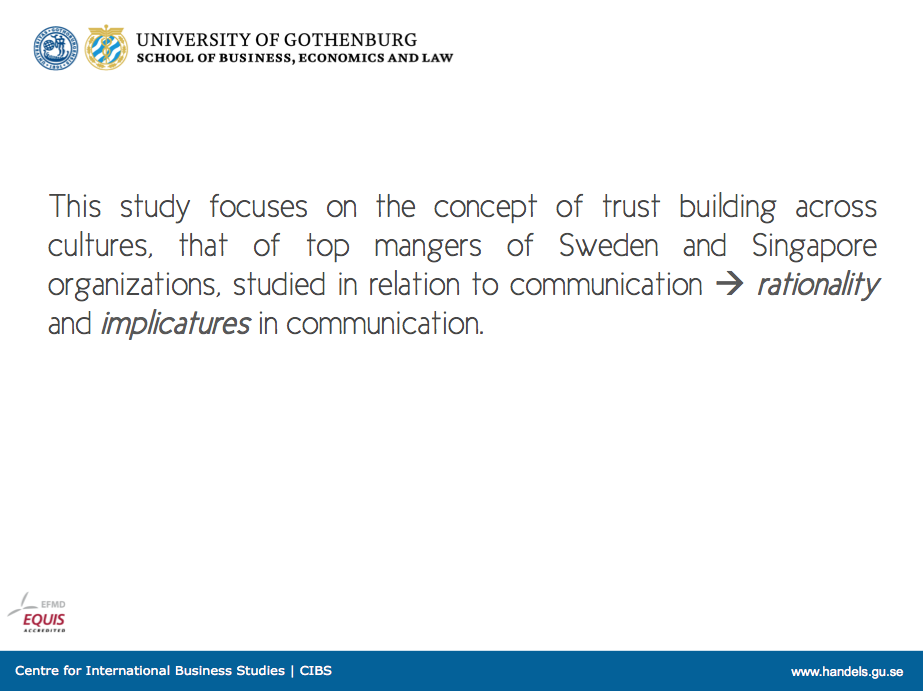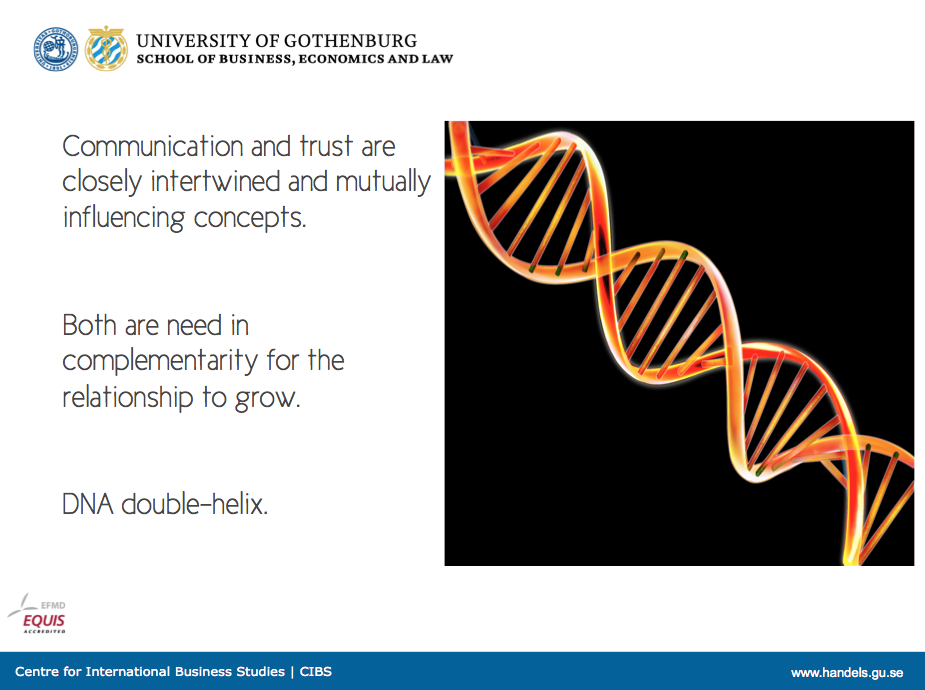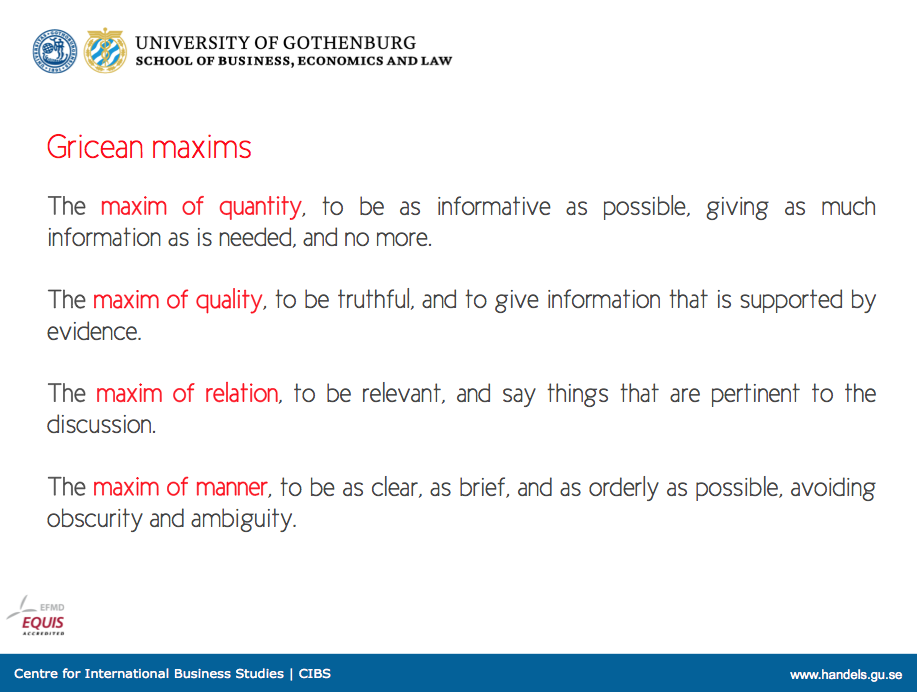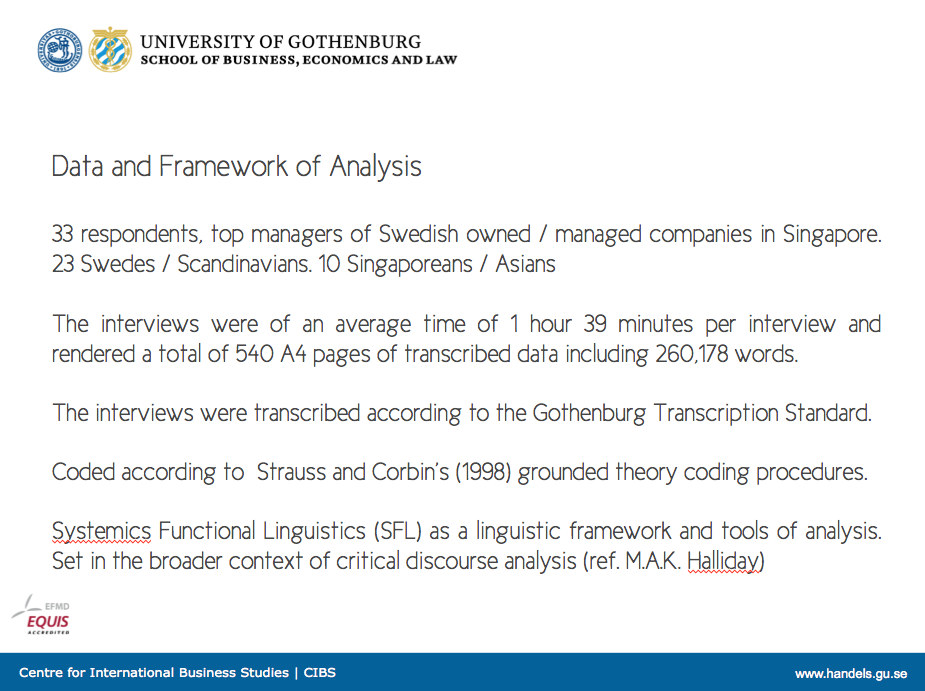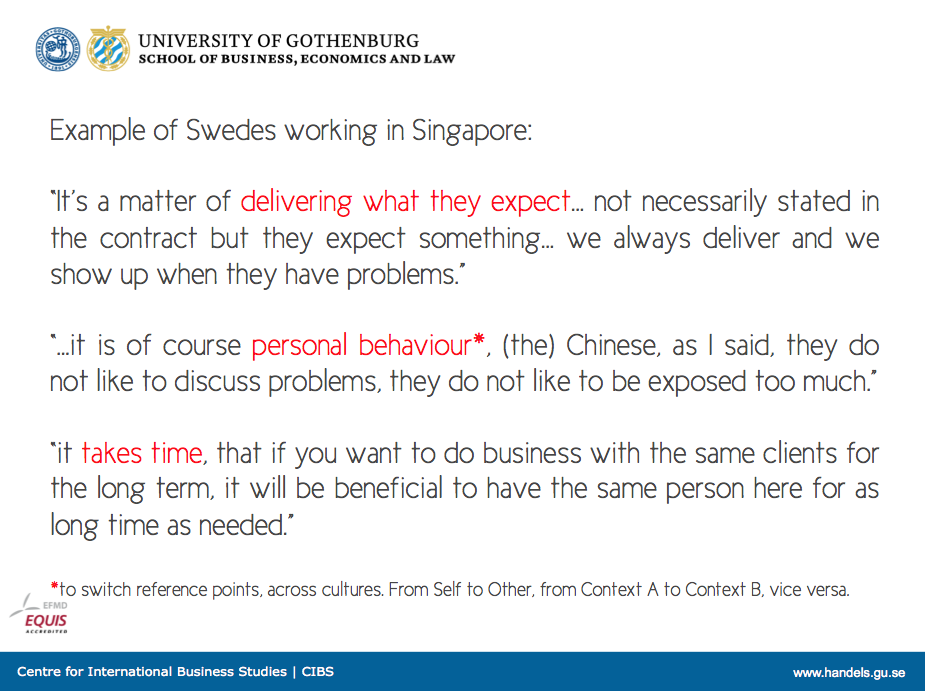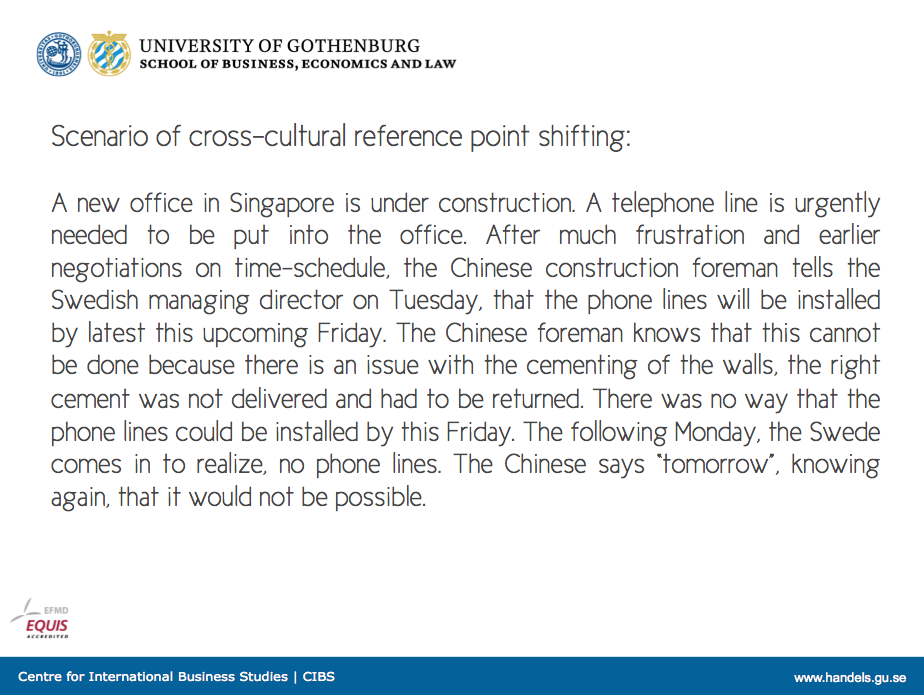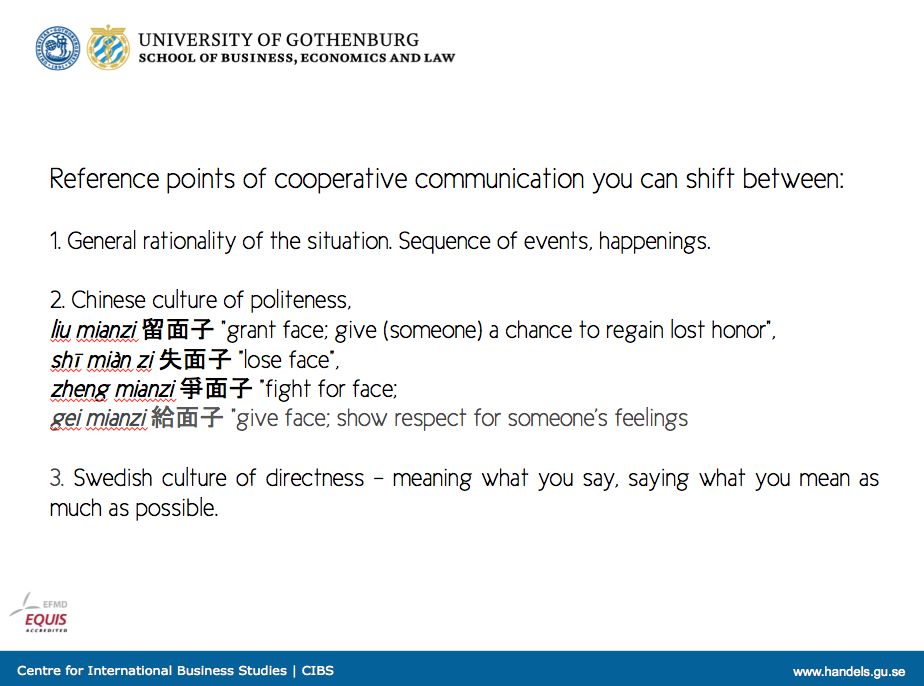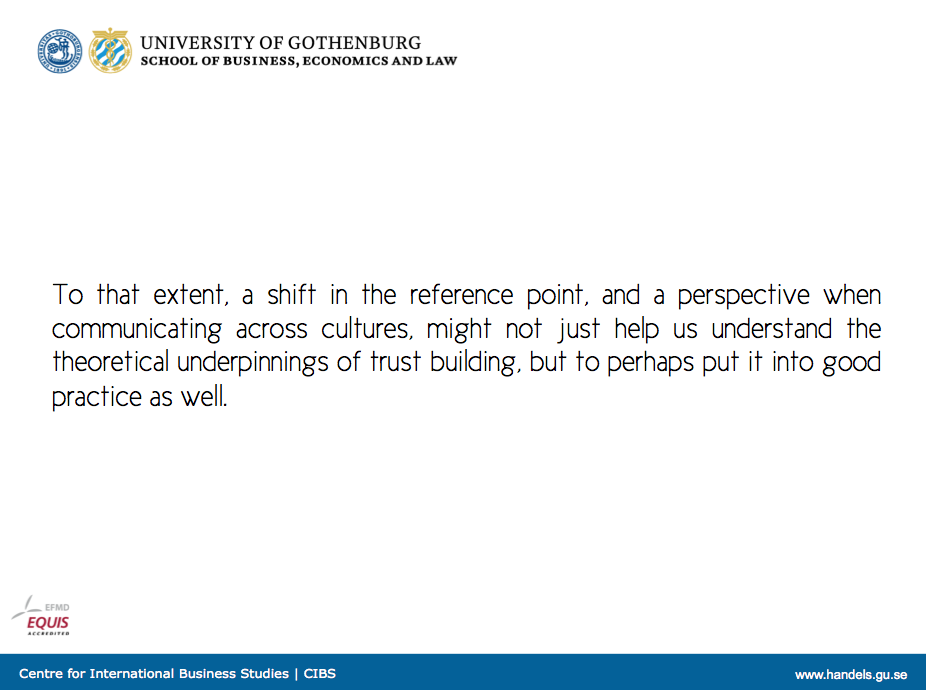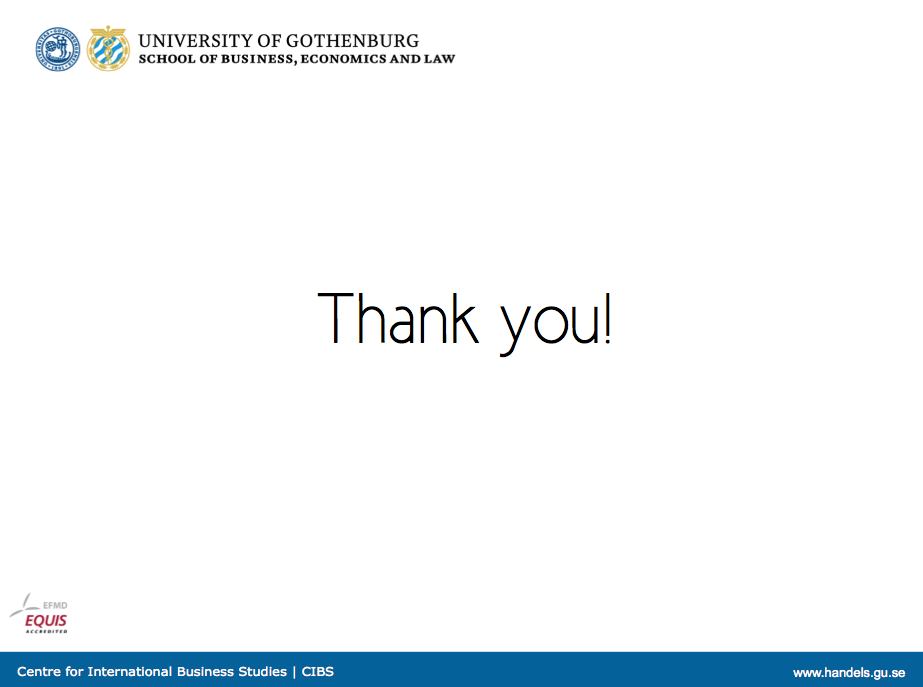The 7th First International Network on Trust (FINT) Workshop on Trust Within and Between Organizations. 21-23 Nov. 2013. Singapore Management University, Singapore
Building trust across cultures: a study of Gricean cooperative maxims of communication between Swedish and Singaporean managers in Singapore.
ABSTRACT
This study focuses on the concept of trust building across cultures, that of top mangers of Sweden and Singapore organizations, studied in relation to communication, from the perspective of applied linguistics with discourse analysis as method of data analysis. Communication and trust are closely intertwined and mutually influencing concepts. This dialectic relation is studied within the contextual framework of Gricean cooperative principles of Quality and Quantity in communication. The research questions include to what extent Gricean cooperative principles apply for the forming of trust across cultures? And are there further mechanisms that can be identified as aspects that support or destroy the foundations of trust building across cultures.
Keywords: organizational trust, Gricean cooperative principles, communication, cross-culture management.
I. INTRODUCTION
When working across cultures, it could be argued that one of the corner stones of a successful venture overseas is the building of trust. Trust is important for successful cooperation and effectiveness within and across organizations (Zaffane, Tipu and Ryan 2011; Thomas, Zolin and Hartman 2009; Nooteboom 2002; Lane 1998), creating and reaffirming friendships (Gibbons 2004), facilitates bargaining and negotiations (Olekalns and Smith 2005), reducing transaction costs exchanges between organizations (Bharadwaj and Matsuno 2006) and aids in abating international political conflicts (Kelman 2005). In terms of investment decisions (Lorenz 1988) trust enables effective investment in assets by assuring parties that there will not be opportunistic behaviour involved whether during or after the agreement has been signed.
The concept of trust is difficult to define and circumscribe because academic literature on the study of trust is extensive. When looked at from the perspective across the various fields, trust is often modeled and defined in accordance to the context of these disciplines. What seems a common element in the aspect of trust is the notion of expectancy and that the other has your best interest in mind. In sociology, Sztompka (1999) defines trust as the expectation that other people, groups or institutions with whom we get into contact, interact and cooperate with will act in ways conducive to our well-being. In the field of management, Six (2007) defines trust as a psychological state of transaction, comprising the intention to accept vulnerability to the actions of another party, based upon the expectation that the other will perform a particular action that is important to you. There are also dimensions of trust that were identified, the first being cognition based and the second, affect based. The former is a rationalistic approach towards the building of trust, where you can observe through the deeds of the other person, behavioural aspects that indicate reliability. The latter is also based in behavioural aspects though distinguished via a mutual emotional bond of care and concern (Chowdhury 2005; McAllister 1995). These two aspects of trust is described by Mayer, Davis and Schoormann (1995) as the difference between competence and benevolence, upon which the authors have built a model of trust, from the perspective of the actor, or the one that trusts.
Models of trust put forth by Zand (1972) and Creed and Miles (1996) have in common, that trust is built and maintained via an interactive and dialogic process. To that extent, it is closely related to communication. Rotter (1967) defines trust in relation to communication as an expectancy held by an individual or group that the word, promise, verbal or written statement of the other can be relied upon. The formal as well as informal timely sharing of information in organizational context is important to trust building, a reason perhaps why the data to this study reflects that the Swedish “fika” or coffee sessions that is a prominent work place culture or feature in Sweden, survived across borders as part of organizational management culture brought by Swedish management to organization subsidiaries in Singapore. These coffee sessions encourage the dialogic process of trust building between individuals within the organization, where trust is both a resulting aspect and function of communication (Cordeiro 2006; Cordeiro-Nilsson 2009).
1.1 Research questions, purpose and scope of study
For the purposes of this study, the concept of trust building across cultures is studied in relation to communication, from the perspective of applied linguistics with discourse analysis as method of data analysis. In this study, I would like to situate communication and trust, seen as closely intertwined and mutually influencing concepts, within the contextual framework of Gricean cooperative principles that arguably form the foundations to trust building between two parties that include the maxims of:
i. Quality: Be truthful. Do not say what you believe to be false or that which you lack evidence for.
ii. Quantity: Be relevant and informative. Make your contribution as informative as required for the current purposes of the exchange. Do not make your contribution more informative than is required, but be clear and concise.
Even if written in the form of guidelines and in prescriptive manner, Grice’s maxims would be better understood as broad premises upon which interlocutors would rely and base their interactions and dialogue upon in order to facilitate a transaction.
These maxims general implicatures, where one criticism of the maxims is that it cannot be universally applied across cultures (Keenan 1976). Yet it is precisely the flouting of these maxims that would make interesting areas of study since what is stated in the maxims are obvious structures of communication in which to build trust, what would happen to the fabric of trust if they were violated? This in turn raises the broader questions of what happens when two differing cultures, with different contextual cues as to what is Quality and Quantity in a communicative process come into contact with each other? How do they navigate the communicative process and build a foundation of trust?
In particular, this study focuses on the building of trust across cultures, between individuals who are in top leadership position of organizations that embody different cultures, across nationalities. It serves to address the three following research questions, percolated from the broader questions outlined above:
1. To what extent can the Gricean cooperative principles of Quality and Quantity as a contextual framework of reference account for the dialectic process of communication and the building of trust between two individuals, across cultures?
2. Apart from the Gricean cooperative principles, what further mechanisms can be identified in the communicative process that contributes to foundational building blocs of trust when working across cultures?
3. If further mechanisms are found, beyond the Quality and Quantity maxims of Gricean cooperative principles, what effect would it have on cross-cultural working relations should these mechanisms not be acknowledged in context?
In this qualitative corpus driven study, the above questions will be answered via analysis of the interview transcripts, where only the most relevant transcript will be selected to be a text example. In this case, the single, most comprehensive piece of text example comes from respondent with initials GEB, who is the Chief Executive Officer (CEO) of a Singapore company, Northpoint, that has continuous close working relations with Swedish and generally Nordic companies based in Singapore. The text example is meant to illustrate the thought processes behind the communicative process in trust building across cultures with the purpose of a continued, successful working relation between organizations.
II. DATA COLLECTION AND RESPONDENTS
The relationship between communication and trust is analysed via empirical data in the form of 33 long interviews collected in 2004 in both Sweden and Singapore with top leaders of Singapore and Swedish organizations based in Singapore.
The interviews were transcribed according to the Gothenburg Transcription Standard, and were then managed via a coding process adapted from grounded theory (Strauss and Corbin, 1998) before applying the tools of systemics functional linguistics (SFL) as a form of critical discourse analysis. The interviews were of an average time of 1 hour 39 minutes per interview and rendered a total of 540 A4 pages of transcribed data including 260,178 words.
Of the 33 respondents, 23 were Scandinavian (21 of 23 were Swedes) and 10 were Asians (7 of 10 were Singaporean Chinese). The targeted group of respondents for the interviews were persons predominantly in leading or managerial positions in these organisations, holding such titles as Managing Director, Chief Executive Officer and Regional Director etc. The respondents came from a wide variety of industrial backgrounds including shipping, finance, food and information technology.
III. METHOD AND FRAMEWORK
In this corpus driven qualitative study, all relevant interview transcripts were analysed using a systemics functional linguistics framework (SFL) for the reasons that it is a method of analysis of language in use that places emphasis on the social character of language based on the model of ‘language as a social semiotic’ outlined in the general works of M.A.K. Halliday from the 1970s onwards. Eggins (2004) provides an introduction to the basic principles of the systemic approach, outlining the general approach to discourse / text analysis. The two major benefits that SFL offers in the analysis of a text (written or spoken) are:
i. It offers an integrated, comprehensive and systematic model of language which enables language patterns to be described and quantified at different levels and in different degrees of detail.
ii. It theorises the links between language and social life so that texts can be seen as reflecting of social life, social identity and interpersonal relations.
Fairclough (2003) also deem SFL as a framework that offers clear and rigorous linguistic categories for analyzing the relationships between discourse and social meaning. It is because of these advantages that SFL has been applied in various fields. A full review of the applications of SFL can be found in Fries and Gregory (eds., 1996).
A sample text chosen because of its length of sequence when speaking about the building of trust between individuals from differing cultural backgrounds and a subsequent sample of SFL analysis on the first 15 clauses of the text is attached in Appendix A. All relevant texts have been analysed in likewise manner for the purposes of this study.
IV. DISCUSSION AND FINDINGS
In answer to the first research question, that Gricean maxims on Quality and Quantity are important especially when communicating across cultures is a feature often reflected in the interview transcripts, where trust is often also connected to expectations, consistency of actions and predictability of behaviour. As one Swedish respondent who works in the shipping industry says:
$B: i think it is a matter of deliver what they expect / if they sign a deal with us / and they expect to get something / it is not necessarily stated in the contract but they expect something / we deliver and we always deliver and we show up when they have problems and try to assist them / then i think you gain trust / and then it is of course personal behaviour/ chinese as i said/ they do not like to discuss problems / they do not like to be exposed too much if you can / it is very difficult to give a chinese or an asian / saying that if you do not do this and this by tomorrow / i will go home / it has to take time and if you act in a good way / sooner or later they will gain trust then it is easier to do business / but it takes time / so i think that if you want to do business with the same clients for the long term / it will be beneficial to have the same person here for as long time as needed / jon for instance / the previous manager / he was here for twelve years
A more interesting feature pertains to the second research question, that is also highlighted in the quotation above and that is when Gricean cooperative maxims, due to cultural structures and values, are deemed by Swedes as flouted. In the above instance, it is the Chinese who “do not like to discuss problems” due to face-saving or a cultural etiquette of politeness.
Another aspect from the Swedish respondents that was highlighted during the coding process of the interview transcripts was the problem of when to tell if “No” means “No” from their Singapore Chinese counterparts, who in the Chinese politeness etiquette, prefer at times, to say “Yes” even when they mean “No”. This feature is yet another example of an apparent cultural flouting of the Gricean cooperative maxims of both Quality and Quantity from the perspective of the Swedes. To a large extent, Swedish respondents have countered this aspect by asking more questions to ensure that their Chinese counterparts understand them, and to ensure that they really mean “No” when they say so.
A third example as illustrated in Text Example 1 in Appendix A lends a case study in answer to the third research question, and that is, a failure on the part of the Swedes to recognize social structures reflected in the organization hierarchy of the Singapore Chinese company can cost a contract signd.
This aspect of recognizing the Chinese vertical organizational structure and sending in the appropriately ranked individuals to negotiate a contract for example, lies distinctly outside of the Gricean cooperative principles of verbal communication. It is what Singaporean GEB constantly refers to speaking and dealing directly with “the number one man” or the “big boss” in order to save time. The recognition from GEB’s Swedish or Nordic counterparts on this structural aspect of hierarchy of the Chinese culture in Singapore that GEB values very much when doing business across cultures, can be costly for the Swedes if not understood in its correct context. Paying attention to corporate hierarchy, titles and rank when working across organizations is important in the Singapore Chinese context, where much of today’s organizations continue still to have central, top-down command. The “big boss” is often seen as the individual with greatest influence and power to make decisions within the organization. If the Swedes were sincere about doing real business, they would likewise send in their “big boss” to speak with the “big boss” of the Singapore Chinese company. Any lesser title sent to the negotiation table might fail from the onset, due to a failure to recognize the vertical structure of the Singapore organization. In the case of GEB in Text Example 1, the recognition of this vertical hierarchy in his organization by the Scandinavians bolsters his opinion that they are honest and open towards him. And he will do business with those who are straight forward and open with him across the negotiation table.
V. CONCLUSION
This study lookED at the relation between communication and trust set in the framework of the Gricean cooperative maxims of Quality and Quantity, where trust can be argued to be both a resulting aspect of and a function of the dialectic process of communication.
When working across cultures, between Sweden and Singapore, while the data showed strong support towards the Gricean maxims of both Quality and Quantity, coupled with expectation, predictability and long term reliability that answered the first research question, what was more interesting in terms of findings relevant to the second and third research questions, was that the maxims proved necessary but not adequate to build trust across cultures per se. Rather, further mechanisms such as the recognition of social structures (a vertical hierarchy in organizations, that is a reflection of the Confucius values) and an understanding of the concept of face, or Chinese politeness etiquette during communication, could well make or break a deal between organizations.
VI. REFERENCES
Bharadwaj, N. and Matsuno, K. 2006. Investigating het antecedents and outcomes of customer firm transaction cost savings in a supply chain relationship. Journal of Business Research, 59(1):62-72.
Chowdhury, S. 2005. The role of affect and cognitions based trust in complex knowledge sharing. Journal of Managerial Issues, 17(3):310-26.
Cordeiro, C. M. 2006. Förtroende över kulturella gränser. Värdet av förtroende. Inga-Lill Johansson, Sten Jönsson, Rolf Solli (eds.) Chapter 14, pp 335-358. Studentliteratur, University of Gothenburg.
Cordeiro-Nilsson, C. M. 2009. Swedish management in Singapore: a discourse analysis study of the concept of trust between Swedish and Chinese managers in Singapore. The New English Teacher, vol 3.1/ 3.2: 82-104. Assumption University Press.
Creed, W. E. D. and Miles, R. E. 1996. Trust in organizations: a conceptual framework linking organizational forms, managerial philosophies and the opportunity costs of controls. In Trust in Organizations: Frontiers of Theory and Research. R. M. Kramer and T. R. Tyler (eds), pp 16-38. Thousand Oaks, CA: Sage.
Eggins, S., 2004. An Introduction to Systemic Functional Linguistics. Continuum: New York, London.
Fairclough, N., 2003. Analysing Discourse: Textual Analysis for Social Research. London: Routledge.
Fries, P. H and Gregoroy, M. (eds) 1996. Discourse in Society: systemic functional perspectives. Meaning and Choice in Language: Studies for Michael Halliday. Volume L in the Series “Advances in Discourse Processes” Roy O. Freedle (ed). Norwood, New Jersey: Ablex Publishing.
Gibbons, D. E. 2004. Freindship and advice networks in the context of changing professional values. Administrative Science Quarterly, 49(2):238-59.
Keenan, E. O. 1976. On the universality of conversational postulates. Language in Society. 5 (1): 67–80.
Kelman, H. C. 2005. Building trust among enemies: the central challenge for international conflict resolution. International Journal of Intercultural Relations, 29(6):639-50.
Lane, C. 1998. Introduction: theories and issues in the study of trust. In Trust within and between Organizations, Conceptual Issues and Empirical Applications. C. Lan and R. Bachman (eds), pp 1-30. Oxford University Press.
Lorenz, E. H. 1988. Neither friends nor strangers: informal networks of subcontracting in French industry. In Trust: Making and Breaking Cooperative Relations. D. Gabmetta (ed), pp 194-210. Oxford: Blackwell.
Mayer, R. C., Davis, J. H. and Schoormann, F. D. 1995. An integrative model of organizational trust. Academy of Management Review, 20(3):709-34.
McAllister, D. J. 1995. Affect and cognition based trust as foundations for interpersonal cooperation in organizations. Academy of Management Journal, 38(1):24-59.
Nooteboom, B. 2002. Trust: Forms, Foundations, Functions, Failures and Figures. Cheltenham: Elgar.
Olekalns, M. and Smith, P. L. 2005. Moments in time: metacognition, trust and outcomes in dyadic negotiations. Personality and Social Psychology Bulletin, 31(12):1696-707.
Rotter, J. B. 1967. A new scale for the measurement of interpersonal trust. Journal of Personality, 35(4):651-65.
Six, F. 2007. Building interpersonal trust within organizations: a relational signaling perspective. Journal of Management of Governance, 11(3):285-309.
Sztompka, P. 1999. Trust: a Sociological theory. Cambridge: Cambridge University Press.
Thomas, G., Zolin, R., and Hartman, J. 2009. The central role of communication in developing trust and its effect on employee involvement. Journal of Business Communication, 46(3): 287-310.
Zand, D. E. 1972. Trust and managerial problem solving. Administrative Science Quarterly, 17(2):229-39.
Zeffane, R., Tipu S. A. and Ryan, J. C. 2011. Communication, commitment and trust: exploring the triad. International Journal of Business and Management, 6(6):77-87.
APPENDIX 1
Text Example 1
$G:…i remember i had one discussion with a finnish guy / so his finance manager one day said / mister x / can my boss come and see you / i said oh please by all means / then he came up here / then he said mister x / oh mister x / our lease is coming up for renewal four months down the road here / we want to negotiate with you /
we chinese / we locals haggle / uhm / i think there’s something that i realise that / when you deal directly with the europeans or the scandinavians / when they are open and straight forward it’s easier for you to sort of come to a compromise / because it’s easier to bridge the gap / especially when you deal directly with the number one man / but there are certain european companies you know / they are big for example / they will send their managers / or somebody senior enough you know / but a local guy to come and talk to you / now that’s where the complications come in / because the local guy wants to score points / to show management that he can do something better / and that’s where the complications enter and the difficulties will come in / whereas when you talk to the europeans / when they are open / you know / straight away they say i think you should give me this discount / then i say yah / i think you’re fair / i’ll just give you something better / to the locals / he or she will tell the boss / oh you know / you gave me this mandate / i got more for you / then she will come and start haggling you know / small little thing start to bicker bicker / try to prove a point blah blah blah
so / there was an agent involved you know / but i always take the initiative that / comes to a stage / i must be personally there to talk to their number one man / sincerely be there / and i’d like you to come in / to give you the best terms i have / even much better than the alternate or whatever
Key
+: positive
-: negative
A: attribute
Ac: actor
Fc: focus
C: connotation
Cp: comparative
M: modality
Jd: judgment
P: possessor
Pd: possessed
PrMa: process, material
PrM: process, mental
PrB: process, behavioural
PrV: process, verbal
PrR: process, relational
PrE: process, existential
PrMet: process, meteorological
S: sayer
Sr: sensor
V: vocative
Va: value
[ø]: ellipsed subject
1i i (Sr) remember (PrM)
1ii i (P, S) had (PrR) one (Fc) discussion (PrV) with a Finnish (Fc, A) guy /
2 he (P) ’s (PrE, PrR) my (Pd) tenant here (PrMet) /
3i so, his (P) finance manager (Pd) one day said (PrV) /
3ii mister x (V) / can (M) my boss (Pd, A) come (PrMa) and see (PrM) you /
4i i (S) said (PrV)
4ii oh please (prV) [ø] by all (Fc) means /
5i then, he (Ac) came (PrMa) up here (PrMet) /
5ii then, he (S) said (PrV)
5iii mister x / oh mister x / (V) our lease is (PrR) coming up for renewal
5iv we (Sr) want (PrM, Ma) to negotiate with you /
6 we (PrR) chinese (Fc) / we PrR) locals (A) haggle (Jd, -C)
7i i (Sr) think (PrM)
7ii there’s (PrE) something
7iii that i (Sr) realise (PrM)
7iv that when you deal (PrMa) directly (Jd, Fc) with the europeans (Jd, A) or the scandinavians (Jd, A) /
7v when they are (PrR) open (Jd, A, +C) and straight forward (Jd, A, +C)
7viα it’s (PrR) easier (Cp, +C) for you to sort of (M) come to a compromise (Va, +C)
7viiβ because it’s (PrR) easier (Cp, +C) to bridge the gap (prMa), especially (Fc) when you (Ac) deal (PrMa) directly with the
7viii number one man (Jd, A) /
8i but there are (PrE) certain (Jd, M, Fc) european (A) companies you know
8ii they are (PrR) big (A) for example /
8iii they will send (PrMa) their managers (Pd) or somebody senior (Jd, Cp) enough you know
9 but a local (A, -C) guy to come and talk (PrMa, PrM) to you
10 now that’s (PrR) where the complications (Jd, V, -C) come in /
11iβ because the local guy (Jd, A, -C) wants (PrM) to score points / to show (PrMa) management
11ii that he (Ac) can (M) do (PrMa) something better (Cp) /
11iiα and that’s (PrR) where the complications (Jd, V, -C) and the difficulties (Jd, V, -C) will (M) come in
12i whereas when you (S) talk (PrV) to the europeans (Jd, A, +C) /
12ii when they are (PrR) open (Jd, V, +C)
12iii you know / straight away (Fc) they (S) say (PrV) i (S) think (PrM) you (A) should (M) give me (PrMa) this discount
12iv then i (S) say (PrV) yah
13i i (Sr) think (PrM) you’re (PrR) fair (A, +C) /
13ii i’ll (M, A) just give you (PrMa, +C) something better (Cp) /
14 to the locals (A, -C) / he or she will (M) tell (PrV) the boss / oh you know / you gave me (PrMa) this mandate / i (Ac) got more (PrMa) for you
14i then she will (M) come (PrMa)
14ii and start haggling (Jd, PrV, -C) you know
14iii small little (Jd, Cp) thing start to bicker bicker (Jd, V, -C) / try to (PrMa) prove a point (Jd, -C) blah blah blah
FINT 2013. PRESENTATION.
